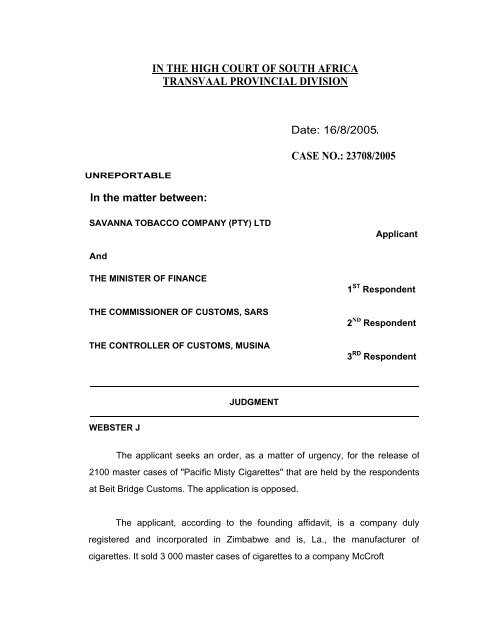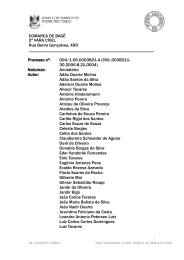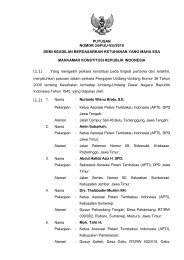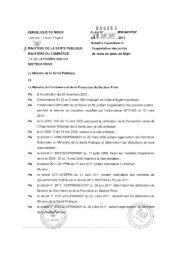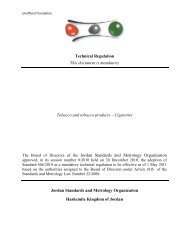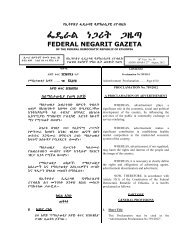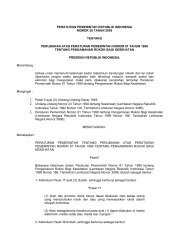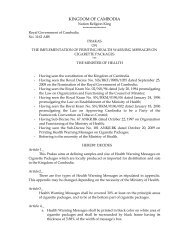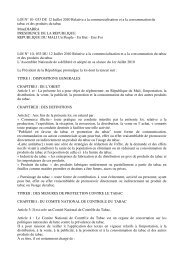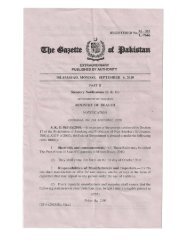IN THE HIGH COURT OF SOUTH AFRICA TRANSVAAL ... - saflii
IN THE HIGH COURT OF SOUTH AFRICA TRANSVAAL ... - saflii
IN THE HIGH COURT OF SOUTH AFRICA TRANSVAAL ... - saflii
Create successful ePaper yourself
Turn your PDF publications into a flip-book with our unique Google optimized e-Paper software.
<strong>IN</strong> <strong>THE</strong> <strong>HIGH</strong> <strong>COURT</strong> <strong>OF</strong> <strong>SOUTH</strong> <strong>AFRICA</strong><strong>TRANSVAAL</strong> PROV<strong>IN</strong>CIAL DIVISIONUNREPORTABLEIn the matter between:Date: 16/8/2005.CASE NO.: 23708/2005SAVANNA TOBACCO COMPANY (PTY) LTDApplicantAnd<strong>THE</strong> M<strong>IN</strong>ISTER <strong>OF</strong> F<strong>IN</strong>ANCE<strong>THE</strong> COMMISSIONER <strong>OF</strong> CUSTOMS, SARS<strong>THE</strong> CONTROLLER <strong>OF</strong> CUSTOMS, MUS<strong>IN</strong>A1 ST Respondent2 ND Respondent3 RD RespondentJUDGMENTWEBSTER JThe applicant seeks an order, as a matter of urgency, for the release of2100 master cases of "Pacific Misty Cigarettes" that are held by the respondentsat Beit Bridge Customs. The application is opposed.The applicant, according to the founding affidavit, is a company dulyregistered and incorporated in Zimbabwe and is, La., the manufacturer ofcigarettes. It sold 3 000 master cases of cigarettes to a company McCroft
2Tobacco Holdings Ltd, a company with its head office in St. Peter Port Guerney,Channel Islands. I shall refer to the latter as "McCroft". The purchased cigaretteswere to be delivered in Iraq, via Turkey.The cases were packed into three containers. Each container had 1 000master cases (i.e. 10 million cigarettes in each container), comprising 600 mastercases of Pacific Misty, 300 Pacific Blue and 100 Pacific Storm.Three (3) trucks towing the trailers on which the containers were loadedwere stopped on 13 June 2005. On 14 June, 2005 the officials of the thirdrespondent searched each trailer in the presence of the applicant's clearing agent.According to the respondents' version which is admitted by the applicant, " ... thefirst rows of master cases loaded in each container contained packets bearing thediamond impression and health warning.”According to the applicant the cigarettes referred to above weremanufactured in Zimbabwe and were in transit through South Africa. It is commoncause that the cigarettes would have attracted no customs or excise levies ortaxes.It is further common cause that all boxes of cigarettes imported into SouthAfrica must bear a stamp impression of a distinguishing mark. It is common causethat the relevant mark is a diamond impression. It is further common cause that allcigarettes sold in South Africa must contain the statutory health warning thattobacco products are a health hazard. The applicant avers in its replying affidavitthat such a warning is not unique to South Africa.Pursuant to negotiations between the parties the cigarettes that did notbear the "diamond impression" and the "health warning" were released to theapplicant's clearing agent. The 2 100 master cases bearing the diamond
3impression and health warning continue to be detained by the respondents. Theyconstitute the subject matter of this application.The 900 master cases that were released to the applicant weresubsequently exported.It is further common cause that various offers were made by the applicantto resolve the impasse regarding the 2 100 cases. These include the payment ofimport duties and taxes, providing an escort at its expense to ensure that thecases are conveyed to the port of export i.e. Durban and are in fact exported. Therespondents will not budge.The applicant's case is that the cigarettes were consigned and enteredSouth Africa in transit for export and accordingly that no offence has beencommitted in respect of the detained goods. They aver further that in accordancewith "The Treaty of the South African Development Community" that waspublished in the Government Gazette 21541 No. R893, and came into operationon 12 September 2000, such goods enjoy freedom of transit and the detention ofthe cigarettes constitutes a breach of the said treaty.The respondents' case is that it has reason to believe that the impoundedcigarettes were intended for sale in South Africa and were not to be exported. Thefirst basis for this belief is based on the presence of the diamond impression andthe health warning. They further allege that they have been investigating thesmuggling of Pacific cigarettes into the country as such cigarettes are being soldin the country without having been imported lawfully. They aver that according totheir intelligence network they were expecting the consignment in issue and hadbeen primed of the deception in packaging of the boxes i.e. that the rows at thedoors were of cigarettes that are legitimately for export. They aver further thatthere is a reasonable belief that the cigarettes may have been
4manufactured locally, smuggled into Zimbabwe and brought back on the pretextof a "removal in transit" with the intention of releasing them on the local market.They aver that locally manufactured cigarettes attract "ad valorem excise dutieswhen released onto the domestic market ... and foreign manufactured cigarette,when imported attract ad valorem customs duties'. They refer to this as "RoundTripping".Some of the reasons for the above-mentioned suspicions are that:(i) the "Certificate of Marine Insurance", excludes theft and hijacking - in therespondents' experience, it is said, diversion and round-tripping ofteninvolve "arranged hijackings" en route to the part of export in South Africa.The hijacked goods thereafter find their way into the domestic market. Therespondent claim that eight such incidents where goods brought intoSouth Africa via Beit Bridge in transit to Durban during 2005, wereallegedly hijacked en route to Durban;(ii) there was no armed escort visible at Beit Bridge as alleged in applicant'sdocuments;(iii) many documents pre-date the letters of intent and only became availableafter 17 June 2005;(iv) all documents forwarded by the purchaser's agent are facsimiles with nosignature by the authors thereof;(v) according to various documents the consignment was to be discharged inMersin (Istanbul, Turkey) yet destined for Iraq;(vi) according to "Image Freight and Logistics" the company transporting thecigarettes the three containers were to be exported " ... to the USA"(Annexure IE10.20);(vii) "Cargo Services" advised the third respondent that the cigarettes were " ...originally consigned for Britten (sic)" (Annexure IEll);(viii) the explanation given by McCroft as to how the diamond impression came tobe on a consignment intended for export is not acceptable. This
5explanation in an unsigned letter from McCroft (Annexure "L" to thefounding affidavit) reads: ''Savanna Tobacco has done an investigation andwe have been advised that the stamp that marks the boxes was decommissionedat the beginning of manufacture by taking the belt off thestamping arm. Howevet; it seems like someone put the belt back intoposition, we assume they were thinking they were doing the right thing.This is the reason the diamond marking has appeared on the 2100 mastercartons.(ix)(x)Savanna Tobacco have been requested to give a report, in writing, .as to why the diamond marking was put on the boxes during manufactureand is herewith accompanying this letter'~when the 900 master cases without the diamond impression werereleased, the parties agreed that two officials would be notified on thearrival of these cases in Durban prior to their export. The applicant failed tohonour this agreement.during the course of its investigation, the respondents' anti-smugglingteam discovered on 30 June 2005 that Pacific-branded cigarettes were ondisplay at Super Spar at Boksburg. The cigarette boxes did not bear thediamond impression as they were supposed to or the health warning. Theywere being sold for R4.95 a packet as opposed to R12.00 to R16.00 at thenormal price. The packets had a ribbon with the words "Not for sale in theR.5.A.'~ No invoice or credit note for the purchase or otherwise could beproduced by Spar. Further, the cigarettes manufactured by the applicantdestined for Zimbabwe diverted to South Africa are alleged to have beentraded illegally in Cape Town and Johannesburg.Mr. Snyman who appeared for the applicant submitted that therespondents bore the onus to prove that the goods were not in transit. Hesubmitted that the goods were in transit and the respondents conduct was
6unlawful and violated La., the provisions of the SADEC TREATY. He submittedthat the containers had been properly sealed and that the offer by McCroft to paythe import customs, or alternatively the insurance cover in the respondents'favour was adequate to protect the interests of the respondents. He submittedfurther that the respondents' conduct could result in serious diplomaticconsequence for this country.Mr. Stais who appeared for the respondents submitted that the cigaretteshad been properly detained. He submitted that the goods had not been seizedand that the respondents were legally entitled to detain the cigarettes pendinginvestigations.RELEVANT STATUTORY PROVISIONSThe relevant statutory provisions are to be founded in sections in theCustoms and Excise Act No. 91 of 1964 (the Act). These are set out below forconvenience:'s.35A. Special provisions regarding cigarettes and cigarette tobacco. -(1) The Commissioner may prescribe by rule-(a) ....(b) distinguishing marks or numbers in addition to the stamp impressionreferred to in subsection (2) which must or must not appear on containersof cigarette tobacco removed from the customs and excise warehouse forhome consumption or for export·(c) .....(2) No licensee may remove any cigarettes or allow any cigarettes to beremoved from a customs and excise warehouse unless -(a) if removed for home consumption, a stamp impression determinedby the Commissioner has been made on their containers; or(b)if removed for export such stamp impression does not appear onthe containers; and
7(c) ....s.87. Goods irregularly dealt with liable to forfeiture. -(1) Any goods imported, exported manufactured warehoused removed orotherwise dealt with contrary to the provisions of this Act or in respect of whichany offence under this Act has been committed (including the containers ofany such goods) or any plant used contrary to the provisions of this Act in themanufacture of any goods shall be liable to forfeiture wheresoever and inpossession of whomsoever found: Provided that forfeiture shall not affectliability to any other penalty or punishment which has been incurred under thisAct or any other law, or liability for any unpaid duty or charge in respect ofsuch goods.(2) Any -(a) ship, vehicle, container or other transport equipment used in the removal orcarriage of any goods liable to forfeiture under this Act or constructed adaptedaltered or fitted in any manner for the purpose of concealing goods;(b) goods conveyed mixed packed or found with any goods liable to forfeitureunder this Act on or in any such ship, vehicle, container or other transportequipment; and(c) ship, vehicle, machine, machinery, plant, equipment or apparatusclassifiable under any heading or subheading of Chapters 84 to 87 and 89 ofPart 1of Schedule No. 1in which goods liable to forfeiture under this Act areused as fuel or in any other manner,shall be liable to forfeiture wheresoever and in possession of whomsoever founds.88. Seizure.-(1) (a) An officer, magistrate or member of the police force may detainany ship, vehicle, plant, material or goods at any place for the purpose ofestablishing whether that ship, vehicle, plant, material or goods are liable toforfeiture under this Act.(b)
8(c) If such ship, vehicle, plant, material or goods are liable to forfeitureunder this Act the Commissioner may seize that ship, vehicle, plant,material or goods.(d) The Commissioner may seize any other ship, vehicle, plant,material or goods liable to forfeiture under this Acts.107. Expenses of landing, examination, weighing, analysis, etc.(1) ...(2) (a) Subject to the provisions of this Act, the Commissioner shall not,except on such conditions, including conditions relating to security, asmay be determined by him, allow goods to pass from his control until theprovisions of the Act or any law relating to the importation or exportationor transit carriage through the Republic of goods, have been compliedwith in respect of such goods, and the State of the Commissioner or anyofficer shall in no case be liable in respect of any claim arising out of thedetention of goods pending the decision of the Commissioner or for thecosts of such detention. "The applicant, in its affidavits, uses the words "detain", "seized" or "seizure"interchangeably. The word detain is defined in The Concise Oxford Dictionary, as "... keep in confinement,· with-held; keep waiting'~ The word detention is definedas " ... detaining; being detained; arrest,· confinement,· compulsory delay'~Dealing with the terms detention and seizure as contained in section 88 of the Act,Van Der Westhuizen J stated in Henbase 3392 v Commissioner, SARS, andAnother 2002(2) SA 180 (TPD) at 191 D to E: ''Detention and seizure orforfeiture, for example in terms of s.87 of the Act, are very different steps as faras the conduct of the respondent is concerned Whereas it can easily beunderstood that for example the audi alterem part em principle mayor has to beapplicable to seizure and forfeiture, the same is not necessarily true regardingmere detention. In terms of sections 87 and 88, detention is the very first stepwhich takes place in order to set in motion a
9process of establishing whether forfeiture should follow'~ I agree wholly withthis exposition.The respondents have made it abundantly clear that their action is not aseizure or forfeiture but a preliminary "with-holding" pending their investigations.They have further invited the applicant to explain about the cigarettes that bearthe diamond impression. I am satisfied that they have not "seized" the cigarettesas contemplated in sections 87 and 88.Mr. Snyman emphasized the fact that the goods, having been in transithad not been "imported". My understanding of his submission is that beinggoods-in-transit the respondents did not have the locus standi nor power todetain the cigarettes.He may have been obliquely referring to the following statement byGoldstone J.A. in Tieber v Commissioner of Customs and Excise 1992(4) SA844at 850 1- 851 A:" ... Goods in transit do not fall into either of those two categories. No purposewould be served in declaring goods in the hold of an aircraft or ship which arenot brought into the Republic. An indication that s.15(1) (of Act 59 of 1990)does not apply to such goods is also to be found in the provision there for acustoms officer to require the person declaring the goods to produce and openthem for inspection. In the usual situation such a requirement would beimpossible to fulfill in respect of goods in transit and not in the physicalpossession of the traveller”. (The underlining is mine). The facts in casu aresubstantially identical to those in the Tieber case - supra.There are several issues that stick out like the proverbial sore-thumb, inthis matter. The respondents acted in consequence of information concerning theillicit smuggling of cigarettes from Zimbabwe. That information concerned
10the applicant directly. The documents presented by the applicant weresuspicious, in most cases bearing no significance and viewed in totalitycontradictory and suspect. There were specific instances of trucks with cigarettesfor export being "hijacked". The Certificate of Marine Insurance (Annexure "H'') isstrange in various important respects. It was tendered and is referred to as beingfor the benefit and security of "Control of Customs and Excise at Beit Bridge". Thedocument is unsigned. The date on it corresponds with the date when the truckswith the containers were detained. The document is ambiguous and if it meansanything at all it limits insurance benefits to "FCD, theft following and hijack",whatever that might mean. In my view the document was correctly rejected by therespondent.In addition to the above there is no explanation forthcoming from theapplicant on a crucial issue, namely the presence of the diamond impression andhealth hazard warning. In the unsigned letter McCroft state that the applicant'sexplanation of these features “... is herewith accompanying this letter'~ No suchletter was annexed to the papers and no explanation has been made by theapplicant. This, to my mind, is devastating to the applicant. I am satisfied thatwhatever onus the respondents bear has been discharged.I revert to the· quotation by Goldstone J.A. in the Tieber case. In my viewthe underlined words in the quotation indicate that the learned judge did notintend and in fact did not lay down an immutable legal principle. In the Tiebercase the goods were definitely in transit. It is my considered view that the exportof the cigarettes was not bona fide but an attempt to smuggle the cigarettes intothis country. Not only has the applicant failed to explain why the detainedcigarettes bore the marks that clearly and unequivocally prove that the cigaretteswere destined for this country but has likewise failed to explain why the cigaretteseligible for export were packed at the door of each container. The inference thatthe intention was to deceive a causal inspection into believing
11that all the cigarettes in each container were for export is irresistible. This wasclearly a case of simulated "export". That being so, the cigarettes were not "intransit". The respondents were entitled to detain the goods whilst conductinginvestigations. In this regard sections 88(1)(a) and 107(2) of the Act authorizesuch detention.I have dealt with this matter on the basis of economic urgency. Strictlyspeaking no case for urgency was made out at all.The application is dismissed with costsG. WEBSTERJUDGE <strong>IN</strong> <strong>THE</strong> <strong>HIGH</strong> <strong>COURT</strong>Date of hearing 21 July 2005Counsel for the ApplicantInstructing AttorneysCounsel for the RespondentsInstructing AttorneysAdv. SnymanPeter SapireAttorneysJohannesburgAdv. StiasThe State AttorneyPretoria


